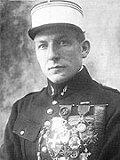|
Charles
Nungesser


Name: Charles Eugene
Jules Marie Nungesser
Country: France
Rank: Lieutenant
Service: French Air Service
Units: N65; Spa65; V106, V116
Victories: 43
Date Of Birth: March 15, 1892
Place of Birth: Paris
Date Of Death: On or after May 8, 1927
Place of Death: Lost at seaDespite many terrible injuries, Nungesser achieved ten
victories in the battle of Verdun. Nungesser's death remains a
mystery. On May 8, 1927, he and Francois Coli left LeBourget Field
near Paris on an historic nonstop flight to New York in a biplane
called l'Oiseau Blanc (the White Bird). They were never seen
again. Following an exhaustive investigation, the French
government published a report in 1984 which concluded that
Nungesser probably reached North America.
Médaille Militaire
"Brigadier of the 2nd Light Cavalry Regiment; on September 3,
1914, with his officer having been wounded during the course of a
reconnaissance, he at first sheltered him, then with the
assistance of several foot soldiers, after having replaced the
officer who was disabled, he secured an auto and brought back the
papers by crossing an area under fire by the enemy." Médaille
Militaire citation
Chevalier de la Légion d'Honneur
"Pilot detached at his own request to an Escadrille in the rear,
has never ceased since his arrival to seek any occasion to fly;
flying up to four hours, thirty minutes each day in spite of the
inclement weather. During the course of his last combat he gave
proof of the highest moral qualities by approaching to within 10
meters the enemy machine he was pursuing firing in response up to
the last moment. He succeeded in downing his adversary which
caught fire and exploded in front of the French trenches."
Chevalier de la Legion d'Honneur citation, December 4, 1915
Officier de la Légion d'Honneur
"Incomparable pursuit pilot, with exceptional knowledge and
magnificent bravery, which reflect the power and inflexible will
of his ancestry. In the cavalry, where during his first
engagements he earned the Médaille Militaire, then in a groupe de
bombardment where for his daily prowess he was cited several times
in orders and was decorated with the Legion of Honour, and finally
with an Escadrille de chasse, for thirty months his exploits were
prodigious, and he always presented himself as a superb example of
tenacity and audacity, displaying an arrogant contempt for death.
Absent from the front several times because of crashes and wounds,
his ferocious energy was not dampened, and he returned each time
to the fray, with his spirit undaunted gaining victory after
victory, finally becoming famous as the most feared adversary for
German aviation. 31 enemy aircraft shot down, three balloons
flamed, two wounds, fifteen citations." Officier de la Legion
d'Honneur citation, May 19, 1918
|
